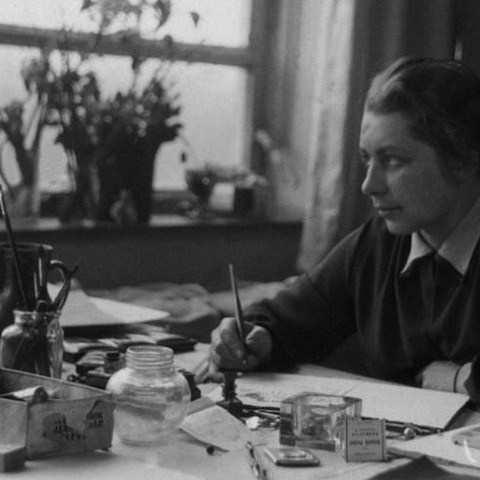Gunta Stölzl began her career studying decorative painting, glass painting, ceramics, art history and style at the School of Decorative Arts in Munich between 1914 and 1916. When Gunta was only 17 years old, she started working as a volunteer nurse at the Red Cross during the First World War. Upon her return she joined the Student Reform Commission and thanks to this, she began to interact with the school of the Bauhaus. Gunta Stölzl began her career in the German school when she made the preliminary course of the Weimar Bauhaus in 1919 by Johannes Itten. The following year she entered the school as a student in the textile workshop, where she studied six years.
Beginnings in the Textile Workshop
When she finished her studies and after the transfer of the Bauhaus from Weimar to Dessau, Stölzl became a teacher of the Bauhaus textile workshop thanks to a large number of students from the school, who caused her promotion by acclaiming her as a leader. In 1927, she even assumed the direction of the fabric section, with the help of Kart Wanke enhancing only the practical side.(2)
In the German school there were no teachers but teachers involved in the form and the workshop, being young teachers. Therefore, it was common for the most outstanding students to receive the position of teachers, as happened to Gunta Stölzl. In her teaching, she applied ideas of modern art he acquired in Johannes Itten's classes (color theory), Paul Klee (visual thinking) and Wassily Kandinsky (abstract art) in a new weaving practice
The fabrics were used as decoration for the architectural space. For this reason, in this period, the artisan pieces were scarce. In addition, new materials were experimented with and sample books were prepared for the industry, so that the workshop activity was professionalized and their expenses were reduced. Gunta Stölzl transformed the weaving workshop into a laboratory where she experimented with all kinds of new techniques and materials.
Beginnings in the Textile Workshop
When she finished her studies and after the transfer of the Bauhaus from Weimar to Dessau, Stölzl became a teacher of the Bauhaus textile workshop thanks to a large number of students from the school, who caused her promotion by acclaiming her as a leader. In 1927, she even assumed the direction of the fabric section, with the help of Kart Wanke enhancing only the practical side.(2)
In the German school there were no teachers but teachers involved in the form and the workshop, being young teachers. Therefore, it was common for the most outstanding students to receive the position of teachers, as happened to Gunta Stölzl. In her teaching, she applied ideas of modern art he acquired in Johannes Itten's classes (color theory), Paul Klee (visual thinking) and Wassily Kandinsky (abstract art) in a new weaving practice
The fabrics were used as decoration for the architectural space. For this reason, in this period, the artisan pieces were scarce. In addition, new materials were experimented with and sample books were prepared for the industry, so that the workshop activity was professionalized and their expenses were reduced. Gunta Stölzl transformed the weaving workshop into a laboratory where she experimented with all kinds of new techniques and materials.
"My first task when I was appointed teacher, in April 1925, was to organize the fabric workshop facilities. [...] Georg Muche (teacher of this section) was little interested in the practical side of the section."(3)
Letter from Gunta Stölzl to Aichele.
"In the fabric section, Gunta Stölzl is required to be recognized as a director and reaffirmed in this position, more protests against teachers."(3)
Ise Gropius.
When, in June 1926, Georg Muche presented his resignation, Gunta Stölzl was already a symbol that made the women of the school think that it was possible to progress and get jobs that were previously unthinkable for Ellass. Stölzl had many students who did not get the diploma because they did not complete all the required semesters, such as the case of Lotte Stam Beese. (4)
In the weaving workshop they always refused to use production processes in a standardized way, but with Gunta Stölzl as a workshop teacher, they themselves reconsidered the situation and became involved with the industry in an intense way. What did not happen is a change of status in the students, as Hannes Meyer suggests, both the tapestries and the experimental fabrics were made by the same hands. "They were daughters of their own time," said H. Meyer. (5)
"In 1922-1923 we had a conception of the house substantially different from today's. Our fabrics could still be poetry full of ideas, floral decorations, individual experiences. Outside the home, they quickly found an echo in a fairly large audience; they were objects more easily understandable, and thanks to the material, more insinuating than all those violently revolutionary products of the Bauhaus. Little by little, there was a transformation. We realized how pretentious those singular pieces were: tablecloths, curtains, tapestries. The richness of colors and forms began to seem too authoritarian, did not allow adaptations, did not submit to the room. Then we strive to be simpler, to discipline our media, to take more account of the possibilities of the material and the function of the object. For that reason we went to the production of fabrics that are sold by the meter, which could be useful to solve the problems of the house. The slogan of this new era was: models for the industry! ".(6)
Gunta Stölzl in 1931
Despite all this, Gunta Stölzl lost her job at the Bauhaus in a similar way to how she won it. A group of dissatisfied students with Gunta after the separation of the marriage with the Jewish architect Arieh Sharon, supported by sympathetic teachers of the right, undertook a campaign against her. Finally, the then director of the school, Mies Van der Rohe, requested her resignation.
Creation of its own weaving workshops
In 1931, she moved to Zurich where she opened craft workshops, creating a large number of works. One of the workshops was S-P-H-Stoffe, together with two former colleagues from the Bauhaus: Gertrud Preiswerk and Heinrich-Otto Hürlimann. It did not take long to be closed due to the economic situation at the time. Later she opened another of them called S-H-Stoffe, until 1937.
The fabrics of Gunta Stölzl are characterized by the solid craftsmanship they require and by the great variety of ligaments used in them. Their carpets give off rhythm and are not limited to a linear or vertical scheme. We can also find figurative motifs, such as cows in the field or religious iconography. Her carpets also remind us of jazz and expressive dance and allow us to get an idea of what the hectic life of this period of the Bauhaus must have been like. Stölzl introduced abstract art into the fabric where we also find a great influence of Johannes Ittenn, reflected in the contrasts and colors. (7)
Until her death in Zurich in 1983, Gunta Stölz was a very active artist; participated in the Society of Swiss Painter, Sculptor and Weaver, and also in the association Werkbund. After her death, the daughters of Gunta, Yael and Monika collected all the documents and works of their mother and established the Gunta Stölz Foundation.
NOTES.-
(1) Jeannine Fiedler, Peter Feierabend. "Bauhaus". Barcelona: Könemann, 2000, p. 346
(2) Ibidem (1), p. 350
(3) Ibidem (1), p. 354.
(4) Thesis by Josenia Hervás y Heras. "El camino hacia la arquitectura: Las mujeres de la Bauhaus". Presented and read at the School of Architecture of Madrid, UPM, on January 29, 2015, p. 527
(5) "Bauhaus Dessau 1927-1930. Experiences of a polytechnic education. "Article published in Edificación magazine, nº 34, July-September 1940 in Mexico City, p.198-209.
(6) Wingler, Hans M .: The Bauhaus. Gustavo Gili, Barcelona 1975, p.206. Booklet edited by the communist students in July 1930. Article by Gunta Stölzl in no. 2 of the bauhaus magazine of 1931, p. 454.
(7) Ibidem (1), p. 351.
(2) Ibidem (1), p. 350
(3) Ibidem (1), p. 354.
(4) Thesis by Josenia Hervás y Heras. "El camino hacia la arquitectura: Las mujeres de la Bauhaus". Presented and read at the School of Architecture of Madrid, UPM, on January 29, 2015, p. 527
(5) "Bauhaus Dessau 1927-1930. Experiences of a polytechnic education. "Article published in Edificación magazine, nº 34, July-September 1940 in Mexico City, p.198-209.
(6) Wingler, Hans M .: The Bauhaus. Gustavo Gili, Barcelona 1975, p.206. Booklet edited by the communist students in July 1930. Article by Gunta Stölzl in no. 2 of the bauhaus magazine of 1931, p. 454.
(7) Ibidem (1), p. 351.
















































